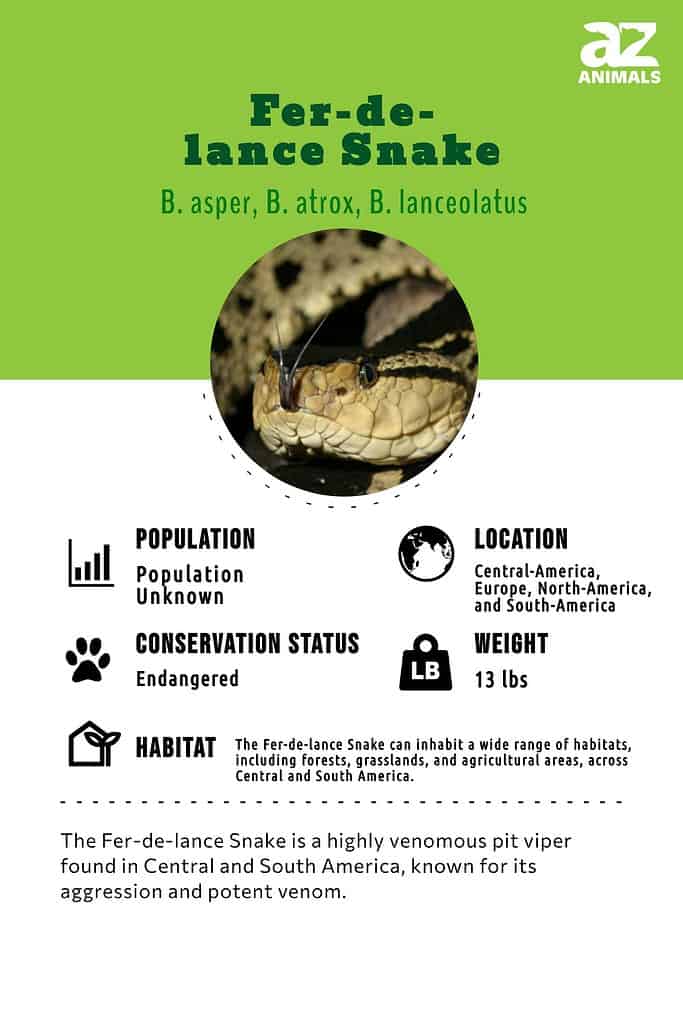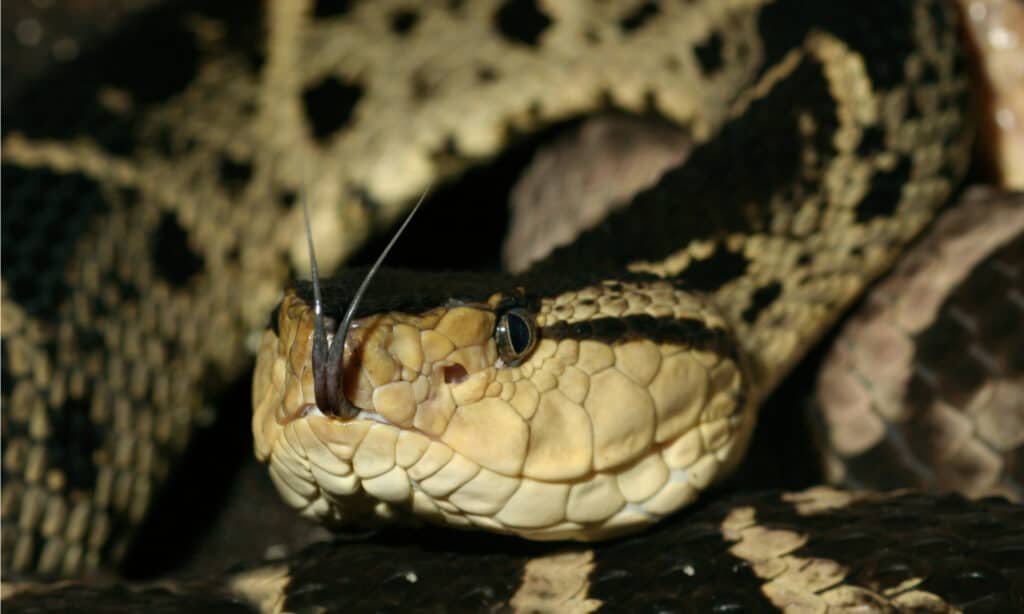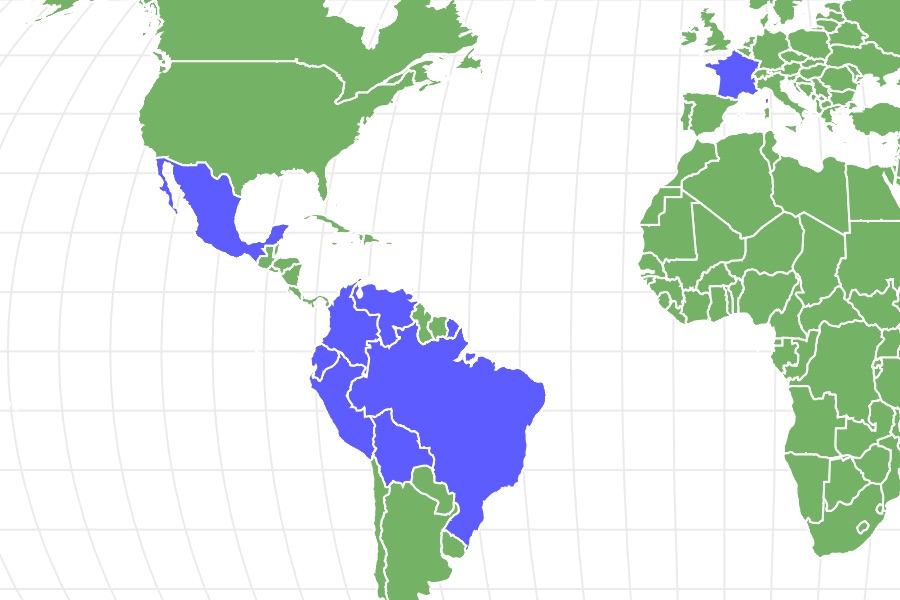Fer-de-lance Snake
B. asper, B. atrox, B. lanceolatus
The Most Dangerous Snake in the Americas
Advertisement
Fer-de-lance Snake Facts
- Prey
- Centipedes, beetles, grasshoppers, crayfish, eels, common possum, Brazilian cottontail
- Name Of Young
- Neonates, snakelets
- Group Behavior
- Solitary
- Fun Fact
- The Most Dangerous Snake in the Americas
- Distinctive Feature
- Dark splotches on brown, olive, gray, rust, green or gray ground
View all of the Fer-de-lance Snake images!

“The Most Dangerous Snake in the Americas”
Camouflage helps these snakes hide from potential prey as well as potential predators, but it also hides them from barefoot people out for a walk.
Like many snakes, this pit viper’s mind is being stepped on, and while it may start to move away from the offending foot, it might just as easily change its mind and bite.
Still, like all snakes, fer-de-lance snakes are fascinating beasts. Read on to learn more about them.
Fer-de-Lance Amazing Facts

The French translation of the name fer-de-lance is “spearhead.”
©Mark_Kostich/Shutterstock.com
Here are five amazing facts about fer-de-lances:
- The meaning of the name fer-de-lance is “spearhead” in French.
- Most fer-de-lance snakes are diurnal, and they can climb trees in pursuit of prey.
- Some scientists give the name fer-de-lance only to Bothrops lanceolatus, also called the Martinican pit viper or the Martinique lancehead. Others also give the name to B. atrox and B. asper, while other people classify most or all snakes in the Bothrops genus as fer-de-lances.
- The fer-de-lance is a crotaline, or pit viper. Like the great majority of pit vipers, eggs develop inside the mother. The eggshells aren’t hard and break inside her when the baby snakes are ready to be born.
- A fer-de-lance is found on Martinique’s “snake flag,” the drapeau aux serpents.
Evolution and Origins
The Martinique lancehead (Bothrops lanceolatus), which is found on the same name-brand island in the West Indies, was the original subject of the title “Fer-de-Lance.” Since then, the aggregate species of the Central and South American genus Bothrops have been referred to by the common name.
The Bothrops asper, commonly referred to as Terciopelo, is a type of pit viper that can be found at moderate to low altitudes across Central America and northeastern Mexico.
This species is also present in South America, with populations residing at elevations up to 2600 meters in the Andes mountains of Colombia and Ecuador, as well as the Caribbean coast regions of Venezuela and Trinidad.
Where To Find Fer-de-Lances
B. lanceolatus is only found in Martinique, a Caribbean island that is part of France, though at least two of these snakes have been found in Guadeloupe. B. atrox, the common lancehead is found in the tropics of south and east Venezuela and southeastern Colombia. It’s also found in Trinidad, French Guiana, Ecuador, Peru, Bolivia, and northern Brazil.
B. asper, called the terciopelo is found in Central America and eastern Mexico and south to Colombia, Ecuador, Venezuela, and Peru.
The snakes live in a wide range of habitats, including tropical rain and evergreen forests, savannas, cloud forests, the lower slopes of mountains, and even deserts.
They are seen in cultivated areas that are also the homes of their rodent prey.
Scientific Name
Fer-de-lance snakes from the New World are members of the Bothrops genus. The meaning of Bothrops is something like “pit eye” and comes from the Greek words bothrops, or “pit” and ops, or eye. It refers to the heat-seeking pit organ between the eye and the nostril in the snake’s head.
Lanceolatus is Latin for “lance-shaped.” This describes the shape of the snake’s head. The meaning of atrox is “cruel, severe, dreadful” in Latin and the meaning of asper is “rough” or “harsh.” This word is also Latin. Asper and atrox probably describe the effects of the venom if a person gets bitten by one of these snakes.
None of these snakes have subspecies.
The Different Types
If you believe that every snake found in the Bothrops genus is a type of fer-de-lance, then they have several things in common. They have a long head that comes to a point that gives them the name “lance head” and a notably sharp ridge between the flat top of their head and the area between their eye and their snout.
They have three to 14 scales at the top of their head. The middle of the back can have 21 to 29 rows of scales, while there are between 139 and 240 scales on the belly and 30 to 86 scales on the underside of the tail. They can grow from 19.5 inches to over 8 feet in length. Every one of them is dangerously venomous and endemic to Mexico and Central and South America.
Fer-de-lances are usually shades of earth colors such as brown, gray, yellow, olive, and black with often geometric blotches at the sides and top of the body. The two-striped forest-pitviper, Bothrops bilineatus is an exception as it is mostly pale green with small black spots.
The conservation status of these snakes ranges from not evaluated to critically endangered in the case of the golden lancehead, B. insularis.
Few of the snakes have subspecies, though Neuwied’s lancehead has seven, and the speckled forest pitviper and the two-striped forest pitviper have two each.
Population and Conservation Status
According to the IUCN Red List, B. lanceolatus’ conservation status is endangered. B. atrox is common and listed as least concern, and so is B. asper’s population as evaluated by the IUCN Red List.
Appearance and Description
B. lanceolatus can grow to about 5 feet long and has brown and black splotches on gray ground. B. atrox can have a variety of ground colors, including brown, olive, gray, or green with undertones of rust or yellow. It sports dark triangles with pale edges whose points meet in the middle of the snake’s back. It can grow as long as 6.5 feet.
The terciopelo’s head is wider and flatter than the heads of the other snakes, and it has distinct “eyelids.” Its head is dark brown to black, with a pale yellow, cream, or white belly.
Like the other snakes, it has triangular blotches that grow denser toward its tail and may have a yellow zig-zag down each side. Females are much bigger and heavier than males and have more scales. A very large terciopelo can be over 8 feet long and weigh over 13 pounds.
How Dangerous Are They?
Fer-de-lances are exceedingly dangerous snakes. The terciopelo is responsible for more snakebite deaths than any other snake in the area where it lives. The common lancehead, which is often found on farms is feared for both its venom and cranky nature, even as it eats vermin. B. lanceolatus, though endangered, is also known to be easily agitated.
The venom of these snakes is a complex mix of toxins that attack the blood and cause hemorrhaging, edema, extreme pain, and necrosis that can lead to cardiovascular shock and kidney failure.
Behavior and Humans
Though fer-de-lance snakes do pose a danger to humans, they are also beneficial in that they eat vermin such as rats and mice. Their venom is also collected and studied to see if it can have some pharmacological use. The venom of these snakes is already used to produce anti-venom to treat snake bites and save the lives and limbs of victims.
Fer-de-lance Snake FAQs (Frequently Asked Questions)
Are fer-de-Lances venomous?
Fer-de-Lances are extremely venomous.
How do fer-de-Lances hunt?
Fer-de-lances don’t hunt so much as they lie in wait for their favorite prey to come within striking distance. The heat-sensing pits in their head tell them when prey is nearby. This is why so many people are bitten by these snakes. They are well camouflaged on unpaved roads and paths and people inadvertently step on them.
Are fer-de-Lances aggressive?
These snakes are known to be very aggressive if they’re annoyed. They’re not only aggressive but unpredictable. It may look like the snake is moving away, but then it may turn and attack.
Where do fer-de-Lances live?
Fer-de-lances live in Mexico and Central and South America in a variety of habitats, including rainforests and even deserts.
What do fer-de-Lances eat?
When these snakes are young their diet is made up of arthropods such as spiders, insects and lizards. As they grow their diet expands to include small mammals, birds, amphibians and snakes that are smaller than they are.
What is a fer-de-Lance?
A fer-de-lance is a very venomous snake that is only found in Mexico and points south in a variety of habitats, including farms. It is a danger to people because it lives so close to human habitations.
How venomous is a fer-de-Lance?
The terciopelo can inject as much as 1530 milligrams of venom in a bite, and a bite with that much venom can probably kill 32 people.
How deadly is a fer-de-lance?
The death rate for people who do not receive anti-venom after they’re bitten by a fer-de-lance is about 7 to 9 percent. But even if you don’t die, the bite can cause such severe necrosis in a limb that you may need to get that limb amputated.
Why is it called a fer-de-lance?
It is called that because its head resembles the tip of a spear.
Can you eat a fer-de-lance snake?
No, fer-de-lances are not edible.
How fast can a fer-de-lance kill you?
How fast you die after a fer de lance bites you depends on how much venom the snake injected. Some snakes don’t inject any venom when they bite, and these bites are described as “dry.” Still, time is of the essence, and you should seek medical help right away if you’re bitten by a fer-de-lance. It’s possible to feel symptoms such as pain, swelling and nausea within 15 minutes after envenomation.
What's the difference between a fer-de-lance and a golden lancehead?
The main difference between golden lanceheads and fer-de-lances is their locations. You can only find the golden lancehead on Snake Island, while fer-de-lance snakes are located in many other South American areas.
Thank you for reading! Have some feedback for us? Contact the AZ Animals editorial team.
Sources
- Wikipedia, Available here: https://en.wikipedia.org/wiki/Bothrops
- ITIS, Available here: https://www.itis.gov/servlet/SingleRpt/SingleRpt?search_topic=TSN&search_value=209554#null
- Britannica, Available here: https://www.britannica.com/animal/fer-de-lance-snake-genus#ref1177100
- Hindawi, Available here: https://www.hindawi.com/journals/jir/2018/3462136/
- Travel Experta (1970)
- Wikipedia, Available here: https://en.wikipedia.org/wiki/List_of_dangerous_snakes#Fer-de-lance

















